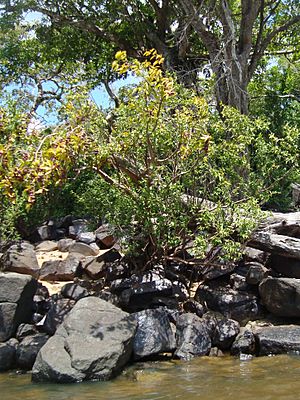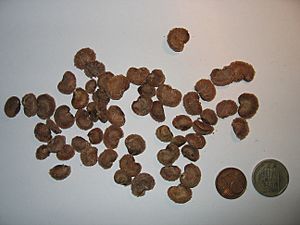Camu-camu facts for kids
Quick facts for kids Camu-camu |
|
|---|---|
 |
|
| Conservation status | |
| Scientific classification | |
| Genus: |
Myrciaria
|
| Species: |
dubia
|
| Synonyms | |
|
|
Camu-camu (scientific name: Myrciaria dubia) is a special plant from the Amazon rainforest. It's also known by names like caçari or araçá-d'água. This small, bushy tree grows along rivers in Peru and Brazil. It can reach a height of 3 to 5 meters (about 10 to 16 feet).
The tree produces a small, red or purple fruit that looks a bit like a cherry. This fruit is famous for having a huge amount of vitamin C. In fact, 2-3% of the fresh fruit's weight is pure vitamin C! Camu-camu is related to other fruit trees like the jabuticaba.
Contents
What Camu-camu Looks Like
Camu-camu trees have small flowers. These flowers are waxy white and have a sweet smell. The tree also has many bushy, feathery leaves.
The leaves are always green and grow in pairs opposite each other on the stem. They are shaped like a spear or an oval. Each leaf can be from 3 to 20 centimeters (about 1 to 8 inches) long and 1 to 2 centimeters (about 0.4 to 0.8 inches) wide.
When the camu-camu fruit is fully ripe, it turns maroon or purple-black. It's usually about 25 millimeters (1 inch) wide. The fruit's inside can be either sweet or quite sour.
Where Camu-camu Grows Naturally
Camu-camu naturally grows in the Amazon lowlands. You can find it in countries like Colombia, Ecuador, Peru, Bolivia, and Brazil. Its home stretches along the middle and upper parts of the Amazon River.
In Brazil, it grows in areas like Pará state and Amazonas. It's often found along big rivers such as the Javarí, Madeira, and Negro Rivers.
How Camu-camu is Harvested
Local people have used wild camu-camu fruit for a long time. They often pick the fruit directly into their canoes. Only recently has camu-camu started to be grown on a larger scale and sold around the world. Japan is one of the biggest buyers.
This tree is quite easy to grow if it has the right conditions. It loves hot, wet, tropical weather. It can even grow in subtropical areas, as long as temperatures stay above freezing. Camu-camu needs a lot of water to thrive.
The trees grow well in areas that flood often. They can survive being underwater for four to five months! New plants grow from seeds. In farms, trees start making fruit about three years after they sprout. They flower at the end of the dry season and produce fruit during the rainy season. These trees can keep producing fruit for many decades.
Wild camu-camu trees can produce about 12 kilograms (26 pounds) of fruit each. If planted closely together, one hectare (about 2.5 acres) of cultivated trees can yield around 12 tonnes (about 26,000 pounds) of fruit.
What's Inside Camu-camu Fruit
Camu-camu fruit is packed with good things for your body! Here's what you might find in 100 grams (about 3.5 ounces) of fresh fruit:
- Protein: 0.4 g
- Carbohydrates: 5.9 g
- Sugars: 1.28 g
- Dietary Fiber: 1.1 g
- Fat: 0.2 g
- Calcium: 15.7 mg
- Copper: 0.2 mg
- Iron: 0.53 mg
- Magnesium: 12.4 mg
- Manganese: 2.1 mg
- Potassium: 83.9 mg
- Sodium: 11.1 mg
- Zinc: 0.2 mg
- Vitamin C: A huge amount, from 1882 to 2280 mg! This depends on how ripe the fruit is.
The amount of vitamin C in camu-camu is incredibly high, making up about 2-3% of its fresh weight. As the fruit gets fully ripe, the vitamin C content might slightly decrease, but its flavor gets stronger.
The fruit also has many healthy plant compounds called flavonoids. These include things like anthocyanins, which give the fruit its reddish color.
How People Use Camu-camu
People in the Amazon have used camu-camu for a long time. While it's not a main food source, its high vitamin C content is very important. The fruit is very sour, tasting a bit like a super tart grape with a large seed inside.
Because it's so sour, camu-camu is often used to make juice. Just like lemonade, it needs a little sugar to taste good. The reddish skin of the fruit gives the juice a lovely pink color.
Recently, camu-camu has become popular in other ways. It's now used in ice creams and sweets. You can also find processed powder made from the fruit pulp. This powder is sold in Western countries as a health food, either loose or in capsules.
Some native groups living along the Nanay River in Peru have also used camu-camu as a traditional remedy. They reportedly used it to help treat malaria.
Keeping Camu-camu Safe
Because camu-camu is becoming so popular, there's a concern about overharvesting wild plants. This could make the species endangered. To prevent this, people are working to encourage more commercial farming of camu-camu in the Amazon River basin. This way, we can enjoy the fruit without harming its natural populations.
See also
 In Spanish: Camu-camu para niños
In Spanish: Camu-camu para niños




